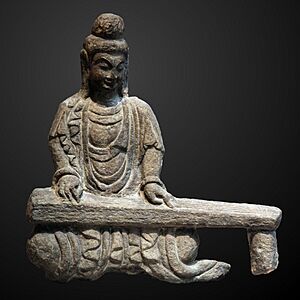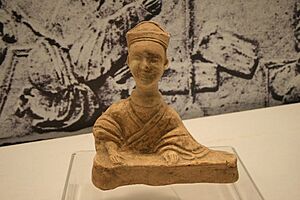History of the guqin facts for kids

The history of the guqin is super old! This amazing Chinese musical instrument has been around for about 3,000 years. It's a type of zither, but don't mix it up with the guzheng, which looks similar but has bridges.
Contents
All About the Guqin
How Old is the Guqin?
Some old stories say the guqin is about 5,000 years old! These legends tell us that famous ancient figures like Fuxi, Shennong, and the Yellow Emperor helped create it. Many old books about the guqin mention these stories as its true beginning. Today, we see these stories as mythology, but they show how much people respected the instrument.
We know the guqin was mentioned in Chinese writings nearly 3,000 years ago. We've also found examples of guqins in ancient tombs from about 2,500 years ago. These early guqins were shorter than today's and probably only played with open strings. This is because their surfaces weren't smooth, and the strings were far from the body, making it hard to slide your fingers.
Chinese tradition says the guqin first had five strings. Then, around 1,000 BCE, two more strings were added, making it seven. Some people think that larger zithers with many strings slowly became smaller, ending up with seven strings. The exact start of the guqin is still a big debate among experts.
How the Guqin Changed Over Time

A Chinese music expert named Yang Yinliu divided the guqin's history into three main periods. In the first period, before the Qin dynasty, the guqin became popular in royal courts and among important people.
In the second period, from the Qin dynasty to the Tang dynasty, the guqin was influenced by ideas from Confucian and Daoist thinkers. Music from Central Asia also played a part. During this time, people started writing down how to play the guqin and how to read its music. The guqin's standard shape was likely set around the late Han dynasty. The oldest guqins that still exist today are from the Tang dynasty. Many of these old instruments can still be played! One of the most famous is called "Jiuxiao Huanpei" 《九霄環佩》. The earliest known piece of guqin music, Jieshi Diao Youlan, also comes from this time.
The third period, from the end of the Tang dynasty to the 20th century, saw many new guqin songs created. Playing techniques also became much better. The Song dynasty is seen as a "golden age" for guqin music. Many poems and essays were written about it, and many famous songs are from this time. Books were also written to explain the music and how to play it. The beauty of the music became very important during this period.
The Guqin Today
In 1977, a recording of a guqin song called "Liu Shui" 【流水】 (Flowing Water) was chosen for the Voyager Golden Record. This special gold-plated record, with music from all over the world, was sent into outer space by NASA on the Voyager 1 and Voyager 2 spacecraft. The guqin piece is the longest song on the record!
Later, in 2003, UNESCO recognized guqin music as one of the "Masterpieces of the Oral and Intangible Heritage of Humanity." This means it's considered a very important part of human culture that needs to be protected and celebrated.
The Guqin in Old Chinese Stories
If you read old Chinese books, you'll often find mentions of the guqin. It appears a lot in Classical Chinese poetry, like in the ancient Shijing (Book of Songs) and many poems from the Tang dynasty.
Guqin in Ancient Poems
The Shijing 【詩經】 (Book of Songs) has several poems that talk about the guqin:
- 「窈窕淑女, 琴瑟友之。」 "Fair and gentle is the maiden; Use qin and se to give her a friendly welcome..." [《關睢》 1]
- 「琴瑟在御, 莫不靜好。」 "The qin and se in your [the husband's] hands; Will emit their quiet pleasant tones..." [《女曰雞鳴》 82]
- 「我有嘉賓, 鼓瑟鼓琴。」 "I have fine guests; So I strum the se, strum the qin..." [《鹿鳴》 161]
- 「妻子好合, 如鼓琴瑟。」 "The love between mother and child; Is like the strumming of qin and se..." [《常棣》 164]
Guqin in Tang Dynasty Poems
In Tang Poetry, we find many mentions, including:
- 「主人有酒歡今夕, 請奏鳴琴廣陵客, 月照城頭烏半飛, 霜淒萬木風入衣, 銅鑪華燭燭增輝, 初彈淥稅後楚妃, 一聲已動物皆靜, 四座無言星欲稀, 清淮奉使千餘里, 敢告雲山從此始。」 "Our host brings wine, for merry-making tonight; And bids the guest from Guangling, to play upon the zither; Moonlight bathes the city walls, crows fly mid-air; Frost petrifies ten thousand trees, wind pierces our robes. But the copper stove gleams bright, and candles add their shimmer; First he plays Lu Water, then The Princess of Chu. As the first note trembles, all else falls silent; From the whole company not a word, till the stars begin to pale. The thousand miles to Qinghuai, I was sent by the Emperor's mandate; On such a night I venture to speak of, retiring to the mountains and the clouds." [A Zither Song : Li Qi, 《琴歌》 : 李頎]
- 「泠泠七弦上, 靜聽松風寒, 古調雖自愛, 今人多不彈。」 "Emotionless the mood of your 'seven-strings'; In the quiet, I sense the cool of the 'Wind through the pines'; I am one who loves the ancient tunes; There are few now who can play them." [Playing the Zither : Liu Changqing, 《彈琴》 : 劉長卿]
- 「蜀僧抱緑綺, 西下峨嵋峯, 爲我一揮手, 如聽萬壑松, 客心洗流水, 餘響入霜鐘, 不覺碧山暮, 秋雲暗幾重。」 "A monk from Shu, clasping a Luqi zither; Descends the west face of Emei peak. He sweeps his hand over the strings for me; And I seem to hear pines sigh in a thousand ravines; And a running stream, that washes the ache from my heart. The faint notes blend with the icy bells. I had not noticed the dusk on the green mountains: How many folds are hidden in the autumn clouds?" [On Hearing Jun, a Monk from Shu, Play the Zither : Li Bai, 《聽蜀僧濬彈琴》 : 李白]
- 「晚年惟好靜, 萬事不關心, 自顧無長策, 空知返舊林, 松風吹解帶, 山月照彈琴, 君問窮通理, 漁歌入浦深。」 "In my later years, I care only for quiet; The ten thousand affairs, no longer concern me. Communing with myself, I find no plan: I only know, I must return to the old woods. A pine wind, will loosen the girdle of my gown; A mountain moon, glitter on my zither. You question me about, success and failure? Listen — a fisherman's song drifting up the estuary!" [A Reply to Assistant Prefect Zhang : Wang Wei, 《酬張少府》 : 王維]
- 「獨坐幽篁裡, 彈琴復長嘯, 深林人不知, 明月來相照。」 "Sitting alone, in the hush of the bamboo; I thrum my zither, and whistle lingering notes. In the secrecy of the wood, no one can hear; Only the clear moon, comes to shine on me." [Hut Among the Bamboos : Wang Wei, 《竹里館》 : 王維]
- The poems above are from the famous book 【唐詩三百首】 Tangshi Sanbai Shou (Three Hundred Tang Poems).



